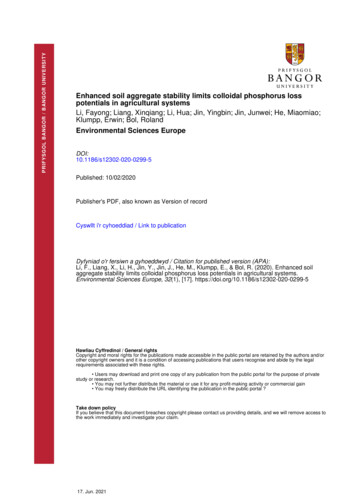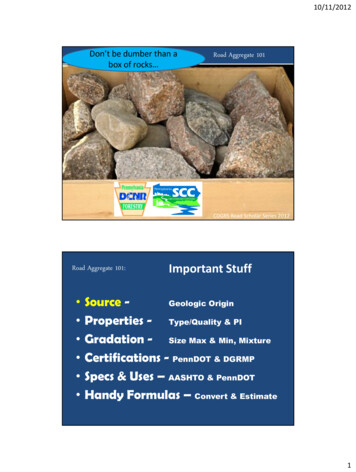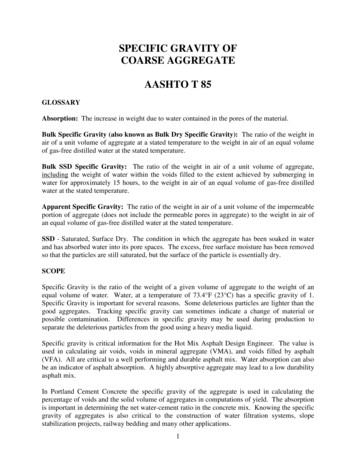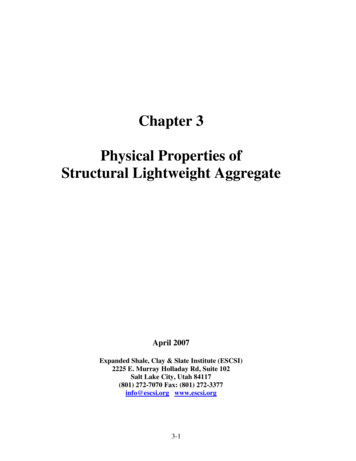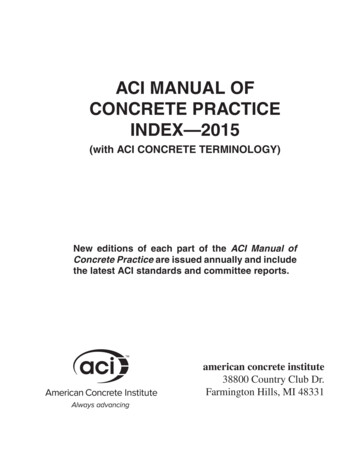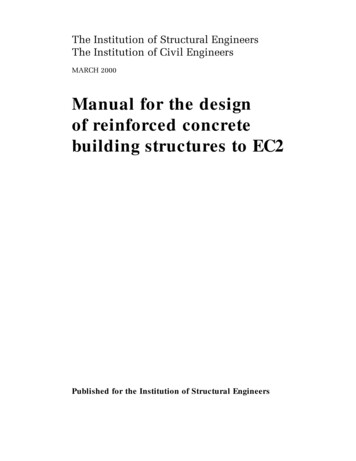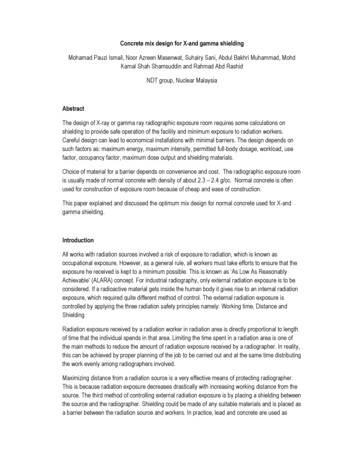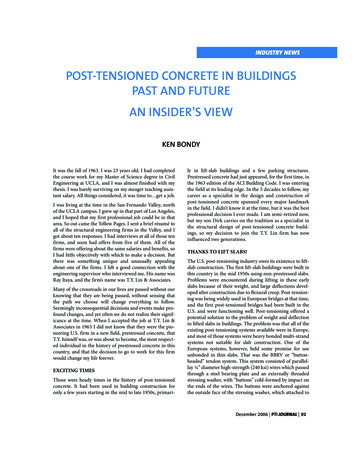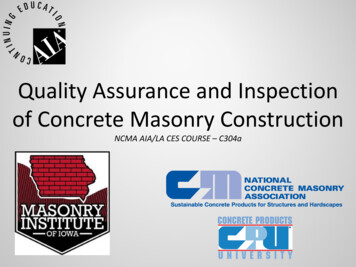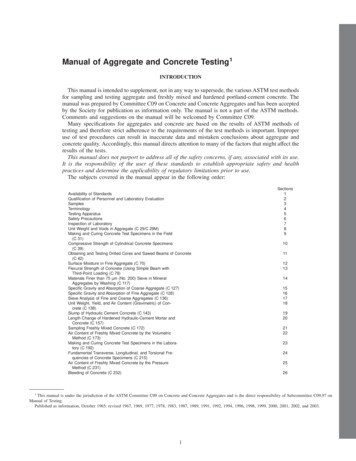
Transcription
Manual of Aggregate and Concrete Testing1INTRODUCTIONThis manual is intended to supplement, not in any way to supersede, the various ASTM test methodsfor sampling and testing aggregate and freshly mixed and hardened portland-cement concrete. Themanual was prepared by Committee C09 on Concrete and Concrete Aggregates and has been acceptedby the Society for publication as information only. The manual is not a part of the ASTM methods.Comments and suggestions on the manual will be welcomed by Committee C09.Many specifications for aggregates and concrete are based on the results of ASTM methods oftesting and therefore strict adherence to the requirements of the test methods is important. Improperuse of test procedures can result in inaccurate data and mistaken conclusions about aggregate andconcrete quality. Accordingly, this manual directs attention to many of the factors that might affect theresults of the tests.This manual does not purport to address all of the safety concerns, if any, associated with its use.It is the responsibility of the user of these standards to establish appropriate safety and healthpractices and determine the applicability of regulatory limitations prior to use.The subjects covered in the manual appear in the following order:Availability of StandardsQualification of Personnel and Laboratory EvaluationSamplesTerminologyTesting ApparatusSafety PrecautionsInspection of LaboratoryUnit Weight and Voids in Aggregate (C 29/C 29M)Making and Curing Concrete Test Specimens in the Field(C 31)Compressive Strength of Cylindrical Concrete Specimens(C 39)Obtaining and Testing Drilled Cores and Sawed Beams of Concrete(C 42)Surface Moisture in Fine Aggregate (C 70)Flexural Strength of Concrete (Using Simple Beam withThird-Point Loading (C 78)Materials Finer than 75 µm (No. 200) Sieve in MineralAggregates by Washing (C 117)Specific Gravity and Absorption of Coarse Aggregate (C 127)Specific Gravity and Absorption of Fine Aggregate (C 128)Sieve Analysis of Fine and Coarse Aggregates (C 136)Unit Weight, Yield, and Air Content (Gravimetric) of Concrete (C 138)Slump of Hydraulic Cement Concrete (C 143)Length Change of Hardened Hydraulic-Cement Mortar andConcrete (C 157)Sampling Freshly Mixed Concrete (C 172)Air Content of Freshly Mixed Concrete by the VolumetricMethod (C 173)Making and Curing Concrete Test Specimens in the Laboratory (C 192)Fundamental Transverse, Longitudinal, and Torsional Frequencies of Concrete Specimens (C 215)Air Content of Freshly Mixed Concrete by the PressureMethod (C 231)Bleeding of Concrete (C 425261This manual is under the jurisdiction of the ASTM Committee C09 on Concrete and Concrete Aggregates and is the direct responsibility of Subcommittee C09.97 onManual of Testing.Published as information, October 1965; revised 1967, 1969, 1977, 1978, 1983, 1987, 1989, 1991, 1992, 1994, 1996, 1998, 1999, 2000, 2001, 2002, and 2003.1
Manual of Aggregate and Concrete TestingFlexural Strength of Concrete (Using Simple Beam withCenter-Point Loading) (C 293)Time of Setting of Concrete Mixtures by Penetration Resistance (C 403)Molds for Forming Concrete Test Cylinders Vertically (C 470)Splitting Tensile Strength of Cylindrical Concrete Specimens(C 496)Moist Cabinets, Moist Rooms, and Water Storage Tanks Usedin the Testing of Hydraulic Cements and Concretes (C 511)Total Evaporable Moisture Content of Aggregate by Drying(C 566)Capping Cylindrical Concrete Specimens (C 617)Resistance of Concrete to Rapid Freezing and Thawing (C 666)Making, Accelerated Curing, and Testing Concrete Compression Test Specimens (C 684)Reducing Samples of Aggregate to Testing Size (C 702)Measuring Early Age Compressive Strength and ProjectingLater Age Strength (C 918)Use of Unbonded Caps in Determination of CompressiveStrength of Hardened Concrete Cylinders (C 1231)Sampling Aggregates (D 75)Force Verification of Testing Machines (E 4)28293031323334353637383940for Use in Construction and Criteria for Laboratory Evaluation,2 identify and define the duties, responsibilities and requirements for personnel and equipment used in the testing andinspection of concrete and related materials.2.2 The Cement and Concrete Reference Laboratory(CCRL),3 under the sponsorship of ASTM Committees C01and C09, and administered by ASTM and National Institute ofStandards and Technology (NIST), formerly the NationalBureau of Standards, has a laboratory inspection service (fordetails of this service, see Section 7) for concrete and concreteaggregates. CCRL also has a proficiency sample program forconcrete, cement and pozzolans. Identical samples of materialare issued to participating laboratories who test the materialand report the results to CCRL. These results are statisticallyanalyzed and a final report issued to the participating laboratories including a rating of their results as compared to all otherlaboratories returning data. A similar reference sample programexists for aggregates. This program, conducted by an organization jointly administered by the Highway Subcommittee onmaterials of the American Association of State Highway andTransportation Officials (AASHTO) and NIST, is called theAASHTO Materials Reference Laboratory (AMRL).42.3 A number of accreditation programs for concrete testinglaboratories exist. The AASHTO Accreditation Program(AAP),5 which uses the CCRL concrete and concrete aggregateinspection for the onsite review of equipment and personnel,the National Voluntary Accreditation Program (NVLAP),6 theConcrete Materials Engineering Council (CMEC),7 and American Association for Laboratory Accreditation (A2LA)8 all offeraccreditation for concrete and concrete aggregate testing laboratories.1. AVAILABILITY OF STANDARDSCopies of the current Annual Book of ASTM Standards, Vol04.02—Concrete and Mineral Aggregates, should be readilyavailable to all laboratory workers and inspectors in the field.Vol 04.01—Cement; Lime; Gypsum contains the Manual onCement Testing which includes valuable information on procedures and apparatus. New editions of ASTM standardsshould be reviewed promptly for changes so that procedurescan be kept current.11.1 Construction specifications may refer to ASTM standards either with or without the year designation. If the yeardesignation is given, the standard bearing that designationshould be used. If the year designation is not given, normallythe standard in effect at the time the bidding documents areissued is the one which is used unless the job specificationsstate otherwise. Sometimes the job specifications might statethat the standard in effect at the time bids are received, or thecontract is awarded, or the current standard should be used. Jobspecifications should be checked to determine that the correctstandard is used, should there be differences. Unfortunately,sometimes job specifications refer to ASTM standards that areobsolete and several years out of date. It is possible in somesuch cases that the specification writer might wish to use anolder standard because of some provision it contains that doesnot appear in later editions.2. QUALIFICATION OF PERSONNEL ANDLABORATORY EVALUATIONThere is increasing emphasis and a requirement in manycases by building codes, political jurisdictions and job specifications that personnel, laboratories, and plants which test,inspect, or produce materials or do construction work beapproved, registered, licensed, inspected, certified, or accredited in various ways.2.1 ASTM Practice E 329, for Use in the Evaluation ofTesting and Inspection Agencies as Used in Construction,2 andPractice C 1077, for Testing Concrete and Concrete Aggregate2273CCRL, National Institute of Standards and Technology, Bldg 226, Rm A365,Gaithersburg, MD 20899.4AMRL, National Institute of Standards and Technology, Bldg 226, Rm A365,Gaithersburg, MD 20899.5AAP, 444 North Capitol Street, N.W. Suite 225, Washington, DC 20001.6NVLAP, National Institute of Standards and Technology, Bldg 101, Rm A531,Gaithersburg, MD 20899.7CMEC, 649 Vassar Street, Orlando, FL 32804.8A2LA, 656 Quince Orchard Road, Gaithersburg, MD 20878.Annual Book of ASTM Standards, Vol 04.02.2
Manual of Aggregate and Concrete Testingunless or until excessive variation develops. Inspectors musttake samples in the manner, at the time, and from the locationspecified in the sampling plan if conclusions based on the dataare to be of value. The purpose of statistical sampling is toobtain results typical of the lot. Samples should not be biasedby procedures that intentionally select either the best or poorestmaterials. Representative samples upon which the acceptanceor rejection of a material is based should be taken by thepurchaser’s authorized agent.3.1 The fundamentals of probability sampling have been setforth by ASTM Committee E11. The coal and ore industries,who have many problems similar to those found in theaggregate field, have developed practical approaches that canbe adapted to the concrete field. The following references areuseful:(1) ASTM Practice E 105, for Probability Sampling ofMaterials15(2) ASTM Practice E 122, for Choice of Sample Size toEstimate the Average Quality of a Lot or Process16(3) ASTM Practice E 141, for Acceptance of EvidenceBased on the Results of Probability Sampling16(4) Bicking, C. A.“ Bibliography on Sampling of RawMaterials and Products in Bulk,” Technical Association of thePulp and Paper Industry, Vol 47, No. 5, May 1964(5) Symposium on Bulk Sampling, ASTM STP 242, Am.Soc. Testing Mats., ASTTA, 1958(6) Symposium on Coal Sampling, ASTM STP 162, Am.Soc. Testing Mats., ASTTA, March 1955(7) Symposium on Bulk Sampling, ASTM STP 114, Am.Soc. Testing Mats., ASTTA, 1951(8) Tanner, L., and Deming, E.,“ Some Problems in theSampling of Bulk Material,” Proceedings, Am. Soc. TestingMats., ASTEA, Vol 49, 1949, pp. 1181–1188(9) Symposium on Usefulness and Limitations ofSamples,” Proceedings, Am. Soc. Testing Mats., ASTEA, Vol48, 1948, pp. 857–895(10) Shook, J. F., “Significance of Test Results Obtainedfrom Random Samples, ASTM STP 362, 1964, p. 13(11) Duncan, A. J., “An Introduction to Acceptance Sampling Plans,” ASTM Standardization News, Vol 3, No. 9,September 1975, p. 10(12) Duncan, A. J., “What Sampling Plan to Use,” ASTMStandardization News, Vol 3, No. 9, Sept., 1975, pp. 15–19(13) Hahn, G. J. and Schilling, E. G., “An Introduction tothe MIL-STD-105D Acceptance Sampling Scheme,” ASTMStandardization News, Vol 3, No. 9, Sept., 1975, pp. 20–30(14) Abdun-Nur, E. A., “Significance of Tests and Properties of Concrete and Concrete-Making Materials,” ASTM STP169B, pp. 5–23Additional information is given in ASTM methods andspecifications, and in publications of the Federal Government,Corps of Engineers, and Bureau of Reclamation.3.2 Samples must be adequately identified and shipped inclean, strong containers. Samples of cement should be shippedin moisture-proof containers, packed in a suitable shipping2.4 A number of technician certification programs alsoexist. These include the following: National Institute forCertification in Engineering Technologies (NICET),9 AmericanConcrete Institute (ACI),10 National Ready Mixed ConcreteAssociation (NRMCA), 11 Portland Cement Association(PCA),12 and the Precast/Prestressed Concrete Institute(PCI).132.5 Other programs include an inspection and certificationprogram of concrete plants by NRMCA, a certification program for special inspector—Reinforced Concrete offered bythe International Conference of Building Officials (ICBO),14and a plant certification program for manufacturers of precast/prestressed concrete offered by PCI.3. SAMPLESAlthough this manual is primarily concerned with testing,some brief remarks about sampling are necessary. Sampling isdiscussed in more detail in later Sections and in ASTM STP 169B, Significance of Tests and Properties of Concrete andConcrete Making Materials. No amount of testing will yieldcorrect answers if the samples are carelessly taken and do notrepresent the material sampled. It is better not to test a materialimproperly sampled because erroneous conclusions can bedrawn from the test results. In any sampling system there areperhaps four stages, each of which requires careful attentionand planning: (1) selection of a sampling plan which willprovide the greatest amount of information at the least cost; (2)physical selection or gathering of samples in accordance withpredetermined procedures for the preselected locations; (3)testing; and (4) analysis of the data obtained. The first and lastof these four items are those that are most often neglected.ASTM Practice D 75, Sampling Aggregates,2 and PracticeC 172, Sampling Freshly Mixed Concrete,2 provide information needed to obtain the samples, but do not discuss theproblem of developing a specific sampling plan. Strictlyspeaking, there is no such thing as a representative sample. Allmaterials are subject to periodic variation. Different shipments,lots, truck loads, car loads, or batches from a given supply willvary to some extent. In addition, the material comprising any ofthe specific units will seldom be precisely homogeneous.However, a successful sampling plan can establish the averagecharacteristic of the material and determine the nature andextent of variability. As data become available it is possible todetect trends and decide if changes in production procedures orprocesses are required to deliver materials of acceptable qualitywith reasonably low percentages of defective or substandardmaterial. Prior to starting of construction, a statistical orprobability sampling plan should be developed and instructionsfurnished to inspectors. Since the amount and nature of thevariations may be unknown, it will be necessary to takesamples more frequently at the start. Later, after patterns arerevealed, it should be possible to decrease sampling frequency9NICET, 2029 K Street, N.W., Washington DC 20006.ACI, 22400 West Seven Mile Road, Detroit, MI 48219.11NRMCA, 900 Spring Street,
Unit Weight and Voids in Aggregate (C 29/C 29M) 8 Making and Curing Concrete Test Specimens in the Field (C 31) 9 Compressive Strength of Cylindrical Concrete Specimens (C 39) 10 Obtaining and Testing Drilled Cores and Sawed Beams of Concrete (C 42) 11 Surface Moisture in Fine Aggregate (C 70) 12 Flexural Strength of Concrete (Using Simple Beam with Third-Point Loading (C 78) 13 Materials .

